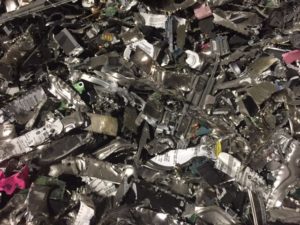So you’ve got old data-storage devices gathering dust in corners of the office that everyone avoids. Sooner or later, you’re going to have to deal with them. But the process of figuring out how to dispose of them properly, and actually making that happen, seems like a big hassle. We get it! What you might not realize is how little effort it will take on your part to dispose of things like hard drives and tapes containing sensitive information. To prove it, here’s the story of a job we just handled that involved hard drive shredding.
 Recently, Northeast Data Destruction was contacted by a government office. (We strictly protect the privacy of all our customers, so we never provide identifying information about them!) This office was looking at options for disposing of thousands of data-storing devices. Like a lot of organizations, they had accumulated a significant number of hard drives, tapes and CDs over the years.
Recently, Northeast Data Destruction was contacted by a government office. (We strictly protect the privacy of all our customers, so we never provide identifying information about them!) This office was looking at options for disposing of thousands of data-storing devices. Like a lot of organizations, they had accumulated a significant number of hard drives, tapes and CDs over the years.
We see this a lot. Companies don’t know how to safely dispose of these items, so they end up dumping them in storage rooms and old filing cabinets and put off doing anything with them. Until the storage space is exhausted, or the business needs to move locations, or compliance regulations require those devices to be destroyed – and then they have a large-scale problem that needs a quick fix.
In the case of this government office, we were called in while they were trying to find a solution. Wiping the drives or simply landfilling the devices was, of course, not an option – nothing but absolute destruction guarantees that sensitive data is protected. That’s true for all organizations. But for a government office, following data destruction best practices is really the only option.
Northeast Data Destruction was called in to make a site visit to assess the situation. All told, the office had approximately 4,000 hard drives and more than 2,000 pounds of tapes that needed to be destroyed. Complicating things was the fact that these devices were scattered throughout a number of municipal buildings and offices.
Our first move was to deliver collection containers to the sites where the devices were being stored. Our personnel handled all aspects of the drop-off process, so that all the government office staff had to do was sort through the collected items and place them in the designated containers. Separate secure, locked containers were designated for hard drives and tapes.
The client let us know when the containers were full and ready for removal. Our staff promptly scheduled a pickup. The client’s containers were transported in a sealed, locked vehicle to our secure processing facility in Mansfield, MA according to NAID guidelines. Our security protocols guaranteed that no one could access the devices between when they were placed in the containers and when they arrived in our processing facility. (This client didn’t request to witness the destruction, but our clients with serious security concerns can choose this option for their own peace of mind!)
The next step was to remove and scan each drive, adding each drive’s serial number to a log. We do this so the client gets an accurate record of everything that was processed. The drives and tapes were then fed into dedicated shredders, permanently destroying the data stored on them. Then we worked with our sister company, Miller Recycling, to recycle the shredded hard drives. Value received from that recycling helped offset the client’s processing cost. Our final step was to provide the client with the destruction log and a NAID “AAA” Certificate of Destruction for their records.
From start to finish, this job took about 10 days. A lot of that time can be attributed to the client filling the secure locked containers that we delivered. Once shreddable material reaches our processing facility, things move quickly – our hard drive shredder can handle up to 500 drives in an hour.
The team at Northeast Data Destruction will handle most of the work associated with properly disposing of your hard drives and other data-storing devices. All you have to do to start the process is to get in touch. We can schedule a site visit and assess your needs, then make recommendations about the most efficient and cost-effective way to proceed. Contact Northeast Data Destruction today to get started.
